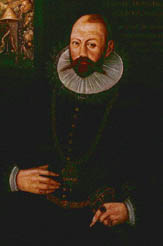![]()

|
Strange, but true!
Tyco Brahe lived by the motto "Non viduri sed esse". Translated into English this statement reads, "Not to be seen but to be." |
Tycho Brahe was born in Denmark in 1546 to a noble family. He was the nephew of Jorges Brahe, a sailor who gave his life in an effort to save the life of King Fredrik II of Denmark. Tycho Brahe benefited greatly from King Fredrik's generous support. Brahe received an island called Hven from the king. He turned this island into his own little country. Brahe built a castle on Hven and named it Uraniborg after Urania, the goddess of the sky. He also built an observatory on the island. For over 20 years, Brahe used the island as his base from which to make astronomical observations. In 1597, Tycho Brahe lost the Danish king's support, so he went to Wandsbech in what is today known as Germany. He eventually settled in Prag where he continued his astronomical observations. Over a 20 year period of time, Tycho Brahe made consistent observations which supported the heliocentric theory proposed earlier by Copernicus. These observations were made using only a compass and a sextant. Brahe catalogued over 1000 stars. He also proved that comets were not just components of Earth's atmosphere, but actual objects traveling through space. Brahe showed irregularities in the Moon's orbit and discovered a new star in the Cassiopeia formation. Brahe invented many instruments such as the Tyconian Quadrant which were widely copied and led to the invention of improved observational equipment. In 1600, Tyco Brahe hired Johannes Kepler as his assistant. In later years, Kepler would use Brahe's work as the basis for the laws of planetary movement which he developed.
Tyco Brahe, though of noble decent, married a commoner. Together they had three sons and five daughters. Brahe died in 1601. His last words, "Ne frusta vixisse vidar" (May I not seemed to have lived in vain") were recorded by his assistant Kepler. Within a few years of his death, the castle and observatory he built on his beloved island Hven were destroyed.
A QuestionWhat instruments did Brahe use to make his astronomical observations? |
| Did you know? |
The Answer |
![]()
| Show me the Level 1 version of this page. |
The StarChild site is a service of the High Energy Astrophysics Science Archive Research Center (HEASARC), within the Astrophysics Science Division (ASD) at NASA/ GSFC.
StarChild Authors: The StarChild Team
StarChild Graphics & Music: Acknowledgments
StarChild Project Leader: Dr. Laura A.
Whitlock
Curator:
Responsible NASA Official: